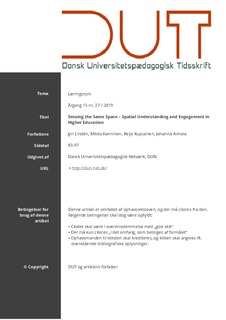| dc.contributor.author | Lindén, Jyri | |
| dc.contributor.author | Kanninen, Mikko | |
| dc.contributor.author | Kupiainen, Reijo P. | |
| dc.contributor.author | Annala, Johanna | |
| dc.date.accessioned | 2019-10-24T06:25:31Z | |
| dc.date.available | 2019-10-24T06:25:31Z | |
| dc.date.created | 2019-10-22T11:05:17Z | |
| dc.date.issued | 2019 | |
| dc.identifier.citation | Dansk Universitetspædagogisk Tidsskrift. 2019, 15 (27), 83-97. | nb_NO |
| dc.identifier.issn | 2245-1374 | |
| dc.identifier.uri | http://hdl.handle.net/11250/2624027 | |
| dc.description.abstract | The aim of this theoretically oriented review is to examine the role of space and spatial thinking in the changing teaching and learning environments in higher education. The starting point is that educational space is not a pre-set institution or only a physical space but a social construction. As such, space is a crucial element in the learning process and student engagement. In the paper, basic concepts of educational space and spatiality are discussed. The complexity of the relations between spatial understanding and student engagement is demonstrated by referring to a specific drama and theatre course as a case example. The case was a joint master-level course between two European universities (in UK and Finland) where multiple online platforms were used. By the means of the learning space in the case, we discuss the nexus of spaces, comprising a dynamic spatial plurality across the learning environments. Blurring boundaries between formal and informal spaces seems to give room for meaningful and embodied experiences - social, situational and emotional connectedness with students in different places. Formal ICT solutions of digital learning do not automatically pay enough attention to spatial aspects of learning and engagement. Understanding the connections between spatial thinking and the meanings of engagement and senses of belonging brings vital elements to the development of digital learning and learning environments. Parallel with the discussions of the distinctive role of interaction and communication in digital environments, spatial understanding can offer an important contribution to increase understanding of personal meanings of learning. Based on the theoretical reflections of the presented case, bodily experiences of the sense of “sharing a space” appears to interrelate with the feelings of belonging and ownership in learning. | nb_NO |
| dc.language.iso | eng | nb_NO |
| dc.publisher | Dansk Universitetspædagogisk Netværk | nb_NO |
| dc.title | Sensing the Same Space – Spatial Understanding and Engagement in Higher Education | nb_NO |
| dc.type | Journal article | nb_NO |
| dc.type | Peer reviewed | nb_NO |
| dc.description.version | publishedVersion | nb_NO |
| dc.source.pagenumber | 83-97 | nb_NO |
| dc.source.volume | 15 | nb_NO |
| dc.source.journal | Dansk Universitetspædagogisk Tidsskrift | nb_NO |
| dc.source.issue | 27 | nb_NO |
| dc.identifier.doi | 10.7146/dut.v14i27.112640 | |
| dc.identifier.cristin | 1739452 | |
| dc.description.localcode | Copyright DUT og artikkelens forfatter. Dette tidsskrift tilbyder øjeblikkelig Open Access til tidsskriftets indhold på baggrund af princippet om, at gratis offentlig adgang til forskning understøtter en større global udveksling af viden. Denne artikel er omfattet af ophavsretsloven, og der må citeres fra den. Følgende betingelser skal dog være opfyldt: Citatet skal være i overensstemmelse med „god skik“. Der må kun citeres „i det omfang, som betinges af formålet“. Ophavsmanden til teksten skal krediteres, og kilden skal angives ift. ovenstående bibliografiske oplysninger. | nb_NO |
| cristin.unitcode | 194,67,70,0 | |
| cristin.unitname | Institutt for pedagogikk og livslang læring | |
| cristin.ispublished | true | |
| cristin.fulltext | original | |
